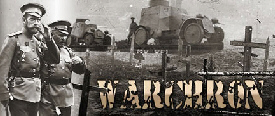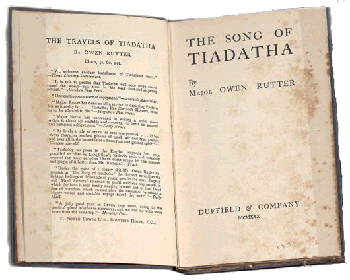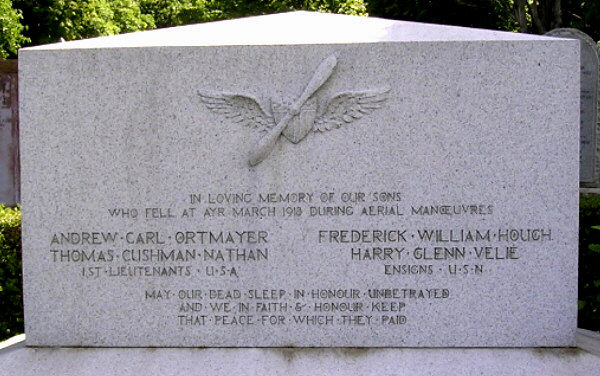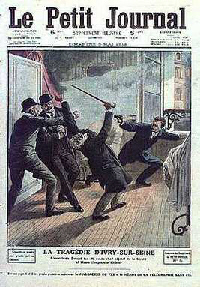
August 2007 |
Access Archives |
TRENCH REPORT: Thanks to all the messages I receive from you readers, I think I'm as well informed about current events related to World War I as anyone could be. With this in mind, you might then be able to gauge the utter surprise I experienced at my neighborhood coffee shop a few weeks ago. I opened the local newspaper, the West County Times, and discovered an obituary for William Seegers, one of the last veterans of the Kaiser's Army, who -- as it turns out -- had resided four blocks from me for the past year. When I called his gracious daughter Virginia Harrison and spoke to her and her son, I further discovered William had been feeling well for most of that time, and would have enjoyed a chat with me about his memories. If I had only known. It would have been wonderful meeting him and then sharing his recollections with you. I did, however, pass on the condolences of our readers and the members of the WWI organizations to the family over their loss. Down in our "Gone West" section you will see an entry for William and a link to an excellent article on his war service and interesting life. Virginia has promised us some wartime photos of her dad after she visits the family homestead in the Philadelphia area. MH
 British Tommies Advance Past Dead German Soldier
 George Sainton Kaye Butterworth, the gifted British composer best known for his settings of A. E. Housman's poems, was killed by a sniper at Pozieres during the Battle of the Somme. However, his body was never found, and he is listed on the memorial at Thiepval Ridge with 73,000 other men who fell in the battle but whose remains were never found.  I expected my sentence and believe it was just. Standing, as I do, in the view of God and eternity I realize that patriotism is not enough. I must have no hatred or bitterness to anyone. Edith Cavell, before her execution |
Trench Exhibit at Carlisle: The U.S. Army Heritage Trail at Carlisle, Pennsylvania, now includes WWI Trench and Lost Battalion exhibits along with depictions of Valley Forge, Antietam, Omaha Beach and other notable American Battlefields. (link) Company K: Our film reviewer, Andrew Melomet, has discovered that the 2004 independent film production based on William March Campbell's Doughboy classic, Company K, is to receive a limited theatrical release soon with DVD sales to follow. We will present more details as they become available.
 Austrian Uniforms in 1914 |
||||||||||||||||||||||||||||||||||||||||||||
|
| |||||||||||||||||||||||||||||||||||||||||||||
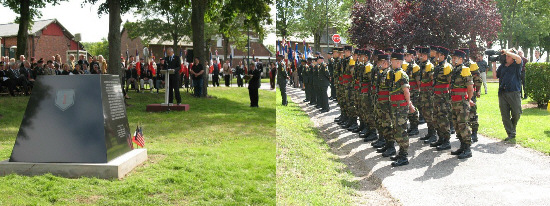
Base Dedicated for the Doughboy Statue Sponsored by the First Division Foundation and Museum
| |||||||||||||||||||||||||||||||||||||||||||||
Click Here for News on Travel Opportunities |
One of Britain's last surviving First World War veterans has died aged 107, leaving only five British survivors of the 1914-18 campaign. William Young, a former trench-based radio operator, was the last known veteran of the Royal Flying Corps (RFC), the forerunner of the Royal Air Force. He died in his sleep earlier this week in Perth, Western Australia, where he lived with his wife May and their son. (link)
William Seegers, 106, a veteran of the German Army, died in Richmond California on July 10th. Drafted late in the war, he was assigned to the 71st Erfurt Battalion. He did mostly office work, but pulled guard duty including watching over prisoners of war. He contracted the influenza at the war's end. William came to America in 1922 and raised his family in the Philadelphia area. He was staying with his daughter Virginia Harrison in Richmond when he died. (link)
Bill Young, the last Scottish veteran of the First World War, has died at the age of 107 at his home in Australia. The war hero served with the Royal Flying Corps during the 1914-1918 war and was held captive by the Japanese in the Second World War. (link)
| |
Hundreds of women were in the crowd, waving handkerchiefs, springing forward out of their line to throw bunches of flowers to those cavaliers, who caught them and fastened them to kepi and jacket. The officers-young dandies of the Chasseurs- carried great bouquets aready and kissed the petals in homage to all the womanhood of France whose love they symbolized. There were no tears in that crowd, though the wives and sweethearts of many of the young men must have stood on the curbstone to watch them pass. In the streets of Paris in those first days of the war I saw many scenes of farewell. All day long one saw them, so that at last one watched them without emotion because the pathos of them became monotonous. It was curious how men said goodbye, often, to their wives and children and comrades at a street corner, or in the middle of the boulevards. A hundred times or more I saw one of these conscript soldiers who had put on his uniform again after years of civilian life, turn suddenly to the woman trudging by his side or to a group of people standing round him and say: "Alors, il faut dire 'Adieu' et 'Au revoir' ! "  Typical Scene Described by GibbsReported by Correspondent Phillip Gibbs |
|
 |
Sleeping Beauty #3
on the Western Front
By Christina Holstein
This month's forgotten vestige of WWI is a concrete trench line in the Ormont region to the southeast of Molleville Farm on the east side of the Meuse, northeast of Verdun. The trench, which runs altogether for about 300 yards, is backed by an observation platform built between two oak trees. The views from this platform provided the Germans on the ground with information about the advancing American troops and allowed them to organize their resistance. The area was finally taken by the AEF's 79th Division at the beginning of November 1918.
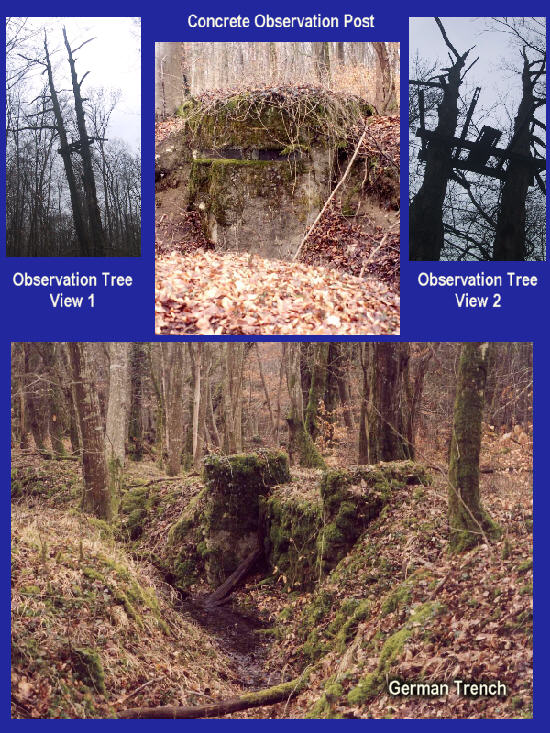

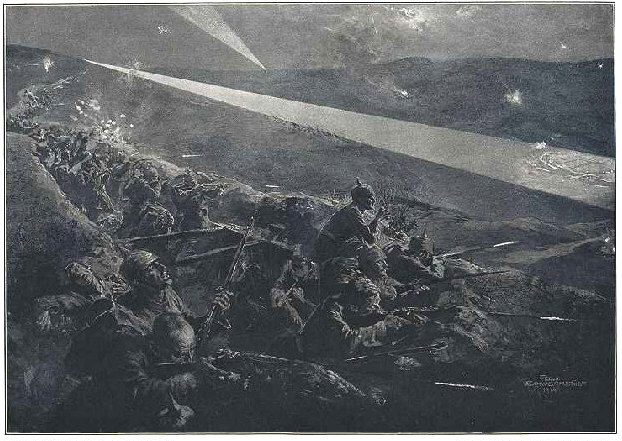
Artist's Depiction of German Trench at the Aisne, September 1914
WWI Trench Warfare Began Here
[Compare to the Trench above in "Sleeping Beauties"]
 |
1917 on The Western Front | |
|
The waiting was not only an imposition on the troops: it was not until 25th July that the British politicians offered their final support to Haig! And the waiting came to an end on a very damp morning at 3:50 a.m. on, Tuesday, July 31st.
The British guns had been hammering the German lines for two weeks, firing over 4 million shells, and now the infantry went over the top on a twelve-mile front. |
Tanks were used both here and later but almost without exception sank or bogged into the August mud, which grew almost on a daily basis. On the afternoon of the first day it rained heavily, and the beeks began to rise, having lost their centuries old courses due to the incessant shelling. (I have walked in Passchendaele mud many times. It weighs mightily on your boots, sticks to everything and permeates your skin). It is evil. | ||||||||
 British Artillery Position in the Salient | |||||||||
|
There had been some changes in the boundaries of the British Armies prior to this time redistributing the responsibilities of the generals. "Thruster" Gough was placed in charge of the main assault. "Daddy" Plumer who had controlled the Salient for many months was given a lesser role. Haig thought that Plumer's methods were not forceful enough for this breakout battle, whereas Gough's were. On the German side was General Sixt von Arnim who had lost the battle at Messines but was a clever and determined fighter. The battlefield is very roughly divided by the Menin Road running SW to NE. There was early success to the West but little to the East where the Germans manned extensive defences to guard against any further losses at Gheluvelt, facing Messines. In general terms, these were a multitude of concrete pill boxes, often sunk to ground level on reverse slopes and each covering several others with interlocking fields of fire. Some still exist in ruins, and the fields of fire they cover are mind-bending. To the attacking troops they were almost impossible to see, and it was necessary to design new tactics immediately to deal with them. A frontal attack was impossible so it was necessary to approach from the sides or, preferably, the rear. But these methods could easily be negated by incoming crossfire from other pill boxes. The problem was obvious, the answer unknown. Flamethrowers were not in common use, a smoke barrage was generally unheard of when attacking a small cluster of strong points, and inevitably it came down to the courage of the lone infantry man..and his luck. If the shelling had moved the nearby landscape so that some of the incoming gunfire was negated, if he could look above the rubbish of the battlefield to register this fact, if he could see a way forward through the slime, if he could make the perilous journey to the pillbox and still live, he could with luck put a grenade through the firing slot and stay alive. Many Victoria Crosses were won in the battle, nearly all of them for destroying strong-points. |
It rained heavily for the next four days. Fierce, bloody and indecisive fighting took place in the old No Mans Land during these fearful days. On the fifth day, the rain stopped but the weather left only sullen skies and intermittent rain.
The mud grew deeper and wider. Haig instructed a Canadian attack against Hill 70 at Loos far to the south. The attack was successful, but it did not weaken the German position or manpower in the Salient. Fighting intensified for ever smaller positions both by attack and counterattack, and many woods and pillboxes were to the point of absolute extermination of the place in question and its garrison. It continued: by mid-August 3½ inches of rain had fallen. Men began to drown in the mud. They or their shattered remains are still entombed below the verdant farmland of the Salient; I have been present when their remains were excavated by the War Graves Staff. There are nearly 54,000 names of men on the Menin Gate and a further 34,000 listed at Tyne Cot; they have all disappeared here, somewhere, and have no known grave. The Germans suffered equally, and the Salient must be the biggest graveyard of unknown soldiers in the world. Haig asked Plumer to extend his lines to the north to break the ongoing deadlock on the Menin Road. This he did, but with the proviso that future operations would be against limited objectives on a "Bite and Hold" basis. Haig accepted. Plumer continued with his planning into September. By the end of August, Haig had lost over 68,000 men since 3:50am on the 31st of July, many of them drowned. Tanks were bogging in the ever deepening mud. He was going to have to make decision whether to continue the battle or not. The politicians in London were waiting. | ||||||||
|
|
|||||||||
 | |||||||||
| |||||||||
| |||||||||
| |||||||||
| The following are thanked for their contributions to this issue of the Trip-Wire: Tom Jones, David Homsher, Susan Neeson, Fred Castier, Tony Langley, August Blume, Sidney Clark, Christina Holstein, Tony Noyes, Andy Melomet, Kimball Worcester, and Len Shurtleff. The World War I Document Archive helped with both our Literary and 90th Anniversary features. The William Seegers article was found at Wikipedia. Until next month, your editor, Mike Hanlon. | SUBSCRIBE TO THE TRIP-WIRE (Or send it to a friend) (Or send us a comment on the TRIP-WIRE) CLICK HERE TO CONTACT US VIA EMAIL |
For further information on the events of 1914-1918
and membership information visit the Directory Pages of:
|
